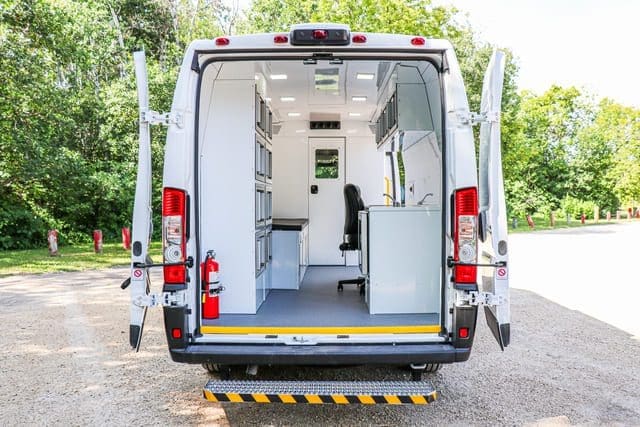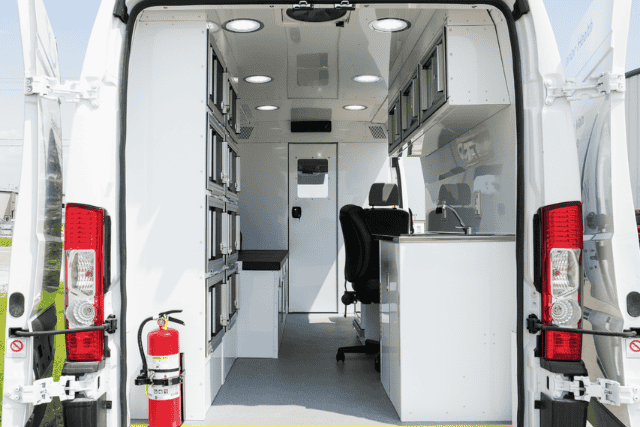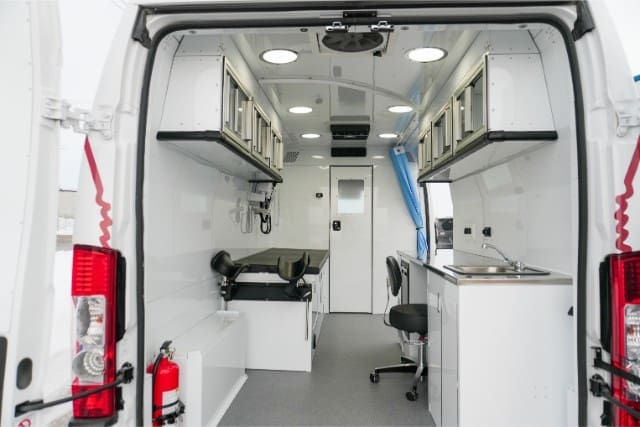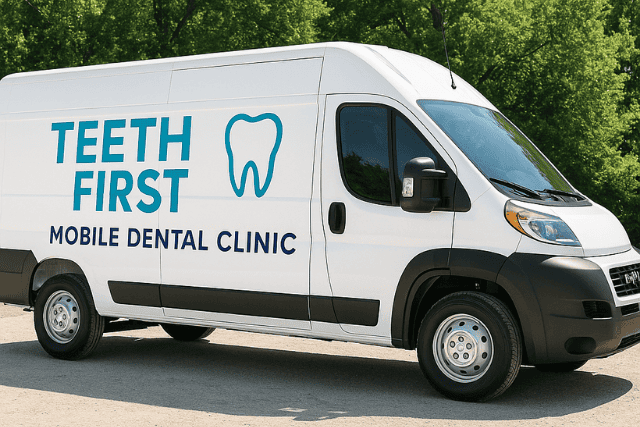Is your organization wondering how to start a mobile medical clinic in the U.S.? Some of the challenges in starting a mobile medical clinic include funding and costs, staffing, community engagement, and marketing and outreach.
At AVAN Mobility, we manufacture mobile medical clinics for organizations like yours that are looking to start a mobile clinic program. We want to see our clients succeed in providing healthcare that saves lives, and that’s why we’re compiling this guide. With over 10 years of experience in the industry, we want to pass some of our knowledge on to you so your journey will be just a little easier.
In this article, you’ll learn all about the 10 steps to starting a mobile medical clinic in the U.S. After you’ve finished reading, we hope you’ll have a clearer idea and a little more direction of what to do next.
Why start a mobile medical clinic in the U.S.?
Mobile medical clinics are an excellent way to provide healthcare services to people who don’t have access to them. Your organization can use mobile clinics to reach people in remote areas, those who are homebound, or those who can’t afford traditional healthcare services. Mobile medical clinics can also be used to provide specialized care, such as dental or mental health services.
Mobile clinics build trust within communities. They provide healthcare services directly to residents. This helps to create a sense of community and support. Your organization can use mobile medical clinics to offer preventive care and health education services. This helps to improve community well-being while increasing healthcare awareness.
According to the International Journal for Equity in Health, between 1,500 and 2,000 mobile medical clinics are estimated to be in the United States. These clinics serve over 6 million patients annually, giving them access to primary care, dental care, and behavioral health services.
Now, let’s dive into each step of starting a mobile medical clinic in the U.S.
10 steps to starting a mobile medical clinic
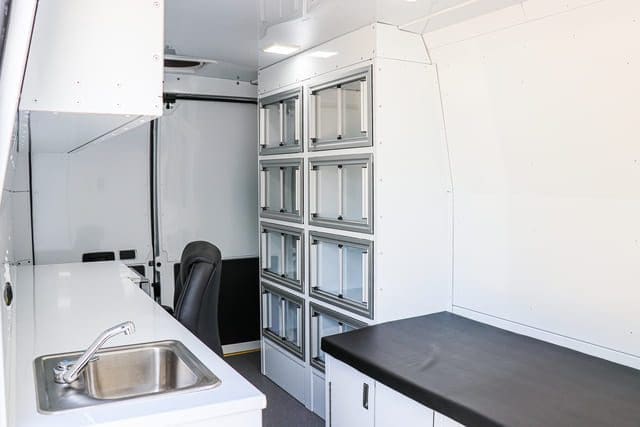
Now that you know more about why organizations start mobile medical clinics, let’s take a closer look at each step involved in the process of beginning one.
If you prefer to learn by watching instead, the video below will cover steps 1 – 5.
Step 1: Define your mission and goals
The first step is to identify the purpose and goals of your organization’s mobile medical clinic.
- What are the specific health needs of the population you want to serve?
- What are the values and principles that guide your work?
- How will you measure your impact and success?
Begin with a clear mission statement. This statement should define why your mobile medical clinic exists and who it aims to serve. In the U.S., missions often revolve around addressing healthcare disparities, promoting wellness, and reducing health inequalities.
Having a clear mission and vision will help you communicate your message and attract support from stakeholders.
Step 2: Conduct a market analysis
The next step is to research the demand and supply of mobile medical clinics in your target area. Some questions your organization should think about in this step include:
- Who are your potential clients and competitors?
- What are the gaps and opportunities in the market?
- How will you differentiate yourself from other mobile medical clinics?
In this step, you also need to research the population demographics in-depth. You need a clear idea of the healthcare needs of the people you’re thinking about serving. One way to do this is by engaging with your target community with surveys.
Based on the survey, you can figure out the potential patient demand for your mobile healthcare services. Conducting a market analysis will help you validate your idea and plan your strategy.
Step 3: Legal and regulatory requirements
Choose the right legal structure for your clinic, such as a nonprofit or for-profit entity. Register your clinic with the appropriate U.S. authorities in your area. This will ensure compliance with federal and state regulations. Nonprofit status is often preferred for mobile clinics, as it can provide tax benefits and align with the charitable nature of the work.
Make sure you obtain all necessary licenses and permits to operate a medical facility in your state. Compliance with U.S. healthcare regulations is crucial for providing safe and effective healthcare services. This step ensures that your clinic operates legally and upholds high standards of care.
Each state has differing federal laws and regulations. For example, in Alabama, you need $1,000,000 of general liability insurance and a written procedure for emergency follow-up care.
For more information on mobile medical regulations by each state, refer to this chart.
Step 4: Develop a business plan
Next, in step 4, make a detailed business plan for your mobile medical clinic. This plan should include information about your company, the market, how you’ll tell people about your clinic, how it will run, and how you’ll manage finances.
It should also explain your mission, goals, and who your clinic is for. In the U.S., mobile medical clinics usually provide things like vaccinations, check-ups, regular care, and help with long-term illnesses, among other treatments. These services should match what the people you want to help need.
Your business plan should also include who can use your mobile clinic’s services. Think about their income, whether they have insurance, their age, and where they live. Being clear about who can get help ensures that you reach the right people in the U.S.
Creating this plan helps you get organized and assists you in securing financing from investors or donors to start your clinic.
Check out this next video covering steps 5 and 6 on how to start a mobile clinic.
Step 5: Secure funding
Running a mobile medical clinic requires a significant financial investment. In the U.S., organizations get money from different places:
Grants and donations: You can ask the government, health foundations, and people or businesses for money. Many organizations in the U.S. give grant money to help with healthcare projects.
Partnerships: You may also need to partner with other organizations, such as hospitals, clinics, schools, churches, or nonprofits, that can provide you with resources or referrals. Securing funding will help you cover the costs of acquiring a vehicle, equipment, supplies, staff, insurance, licenses, permits, and marketing.
Read our guide on securing grants for mobile health clinics in the U.S. to help streamline this step. You should also read our article on the top 6 ways to apply for mobile health grants. This article includes some of the most common ways to secure grant financing in the U.S.
Step 6: Purchase a mobile medical van
In this step, it’s time to look for a manufacturer to build your mobile medical clinic. You’ll need to customize it to fit your needs, like its size, layout, design, and more. You’ll also want to put your logo, organization name, and contact info on it. Getting a vehicle helps you take healthcare where it’s needed.
Choosing the right manufacturer for your mobile medical clinic van is really important. Work with trusted companies like us at AVAN Mobility to make sure it meets your needs. In the U.S., mobile medical vans should have all the equipment you need to give complete care to your patients.
Additionally, taking care of your mobile medical clinic is a must. Create a maintenance plan to keep it in good shape. Regular check-ups and following safety rules are crucial, especially because mobile clinics travel a lot in the U.S.
Read our article on mobile medical van customization for a closer look at some of the available customization options.
If you’re going to be running something like a mobile flu clinic, refer to this mobile clinic checklist.
Keep reading to learn about the last few steps in starting a mobile clinic, or watch the video below!
Step 7: Hire staff
In step 7, your organization needs to hire qualified and experienced staff. Depending on what type of mobile medical vehicle you’re running, some of the staff you’ll need include:
- Nurses
- Physician assistants
- Nurse practitioners
- Doctors
- Social workers
- Counselors
In the U.S., healthcare professionals should hold the necessary state licenses and certifications to practice.
Once you hire staff, provide comprehensive training. This will include teaching them mobile clinic operations, patient care, cultural competence, and community engagement. U.S.-specific training includes understanding the diverse healthcare landscape and unique healthcare challenges in different regions of the country.
Step 8: Outreach and marketing
At this point, it’s time to start promoting your mobile medical clinic. Build strong connections with the people who live nearby. This is super important for mobile clinic programs to work well. Go to local events, health fairs, and community gatherings to spread the word about your services. This will help earn the community’s trust in you.
Some of the other ways to spread awareness about your mobile medical clinic in the U.S. is through social media, local newspapers, community newsletters, and teaming up with local media.
Step 9: Establish partnerships
Team up with local healthcare providers, hospitals, clinics, pharmacies, and specialists. Working together is crucial to offering a wider range of services and making sure patients can easily get specialized care when they need it. These partnerships also help make your mobile medical clinic in the U.S. more successful.
Strengthen ties with community groups and nonprofit organizations. They can provide support, send referrals, and connect you with the communities you serve. Partnering with local nonprofits can make your clinic in the U.S. have an even bigger impact because they’re already familiar with the market.
Step 10: Launch and evaluate
The final step for starting a mobile medical clinic in the U.S. is to host a launch event to introduce your mobile medical clinic to the community. Invite local leaders and media to create buzz and generate interest in your services. In the U.S., public awareness events can help establish your clinic’s presence and build trust.
Collect feedback from patients, community partners, and stakeholders. Use this feedback to continuously improve your services. Regular evaluations and adjustments are vital for achieving your mission effectively and adapting to the evolving healthcare landscape in the U.S.
Make a list of data that includes:
- The type of services you provided
- The outcomes achieved
- Positive and negative feedback
- Expenses incurred
- Challenges faced
- Lessons learned
Let’s look at an example of someone launching a mobile medical clinic from scratch.
Travis, a passionate paramedic from a small U.S. town, drew inspiration when he saw a picture of AVAN Mobility’s Mobile Medical Clinic. He envisioned it serving his community, where healthcare access was limited. Gathering a team of volunteers and securing funding through community efforts, Travis’s dream became a reality.
The arrival of AVAN Mobility’s Mobile Medical Clinic marked a turning point. Equipped with cutting-edge medical facilities, it was ready to serve the town.
Travis and his team engaged the community through events, schools, and collaborations, generating excitement. When the clinic opened, Travis welcomed patients personally, fostering a warm, personal connection.
Listening to patient feedback, Travis adapted the clinic’s services to meet the community’s specific needs. AVAN Mobility’s Mobile Medical Clinic not only provided healthcare but also symbolized unity in the town.
Travis exemplified AVAN Mobility’s mission, proving that with determination and community support, healthcare can be accessible to all.
Exploring Further with AVAN Mobility
You made it to this article looking for more information on how to start a mobile medical clinic in the U.S.
Now that you learned about the 10 steps involved in that, it’s time to move forward and start researching manufacturers. Take a look at these 2 comparison articles below that compare us to different manufacturers:
You should also read this article on how to choose a mobile medical van for your organization. This will steer you in the right direction on important things you should consider before purchasing one.
Our team at AVAN Mobility wants to ensure you make informed decisions when starting your mobile medical clinic. We’re here to support you in your journey and share our expertise from over a decade in the industry. Talk to an expert today for more information.
FAQ
Q: How much does it cost to start a mobile medical clinic in the U.S.?
A: The costs vary, but it typically ranges between $125,000 to $225,000. Final costs depend on factors like the size of the clinic and the equipment needed.
Q: What are the key challenges of running a mobile medical clinic in the U.S.?
A: Some of the challenges include securing funding, reaching your target population, and adjusting to different healthcare needs.
Q: What regulations should I be aware of when operating a mobile medical clinic?
A: You must comply with federal and state healthcare regulations, including licensing, insurance, and adherence to safety standards.


